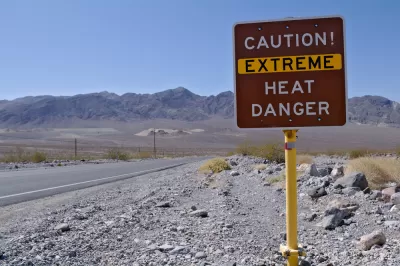A new UCLA study examines how formal and informal cooling centers are being used in Los Angeles County.

As climate change makes heat waves longer and more severe, people turn to both formal and informal cooling centers for relief in Los Angeles County. Formal cooling centers are typically offered at libraries, parks, and other public facilities. Informal ones are places like shopping centers, coffee shops, and other indoor spaces with AC. As reported in this article by David Colgan, a new UCLA study published online in the journal Applied Geography uses smartphone data to examine for the first time how formal and informal cooling centers are being used in L.A. County.
The study reveals that:
- About 20 percent of the population uses cooling centers in the county.
- The vast majority of those who visit cooling centers use shopping malls and other informal cooling centers; far fewer visit official cooling centers.
- When temperatures reach or exceed 95 degrees, the cooling centers that see the greatest increase in visits are those located near public transit stops.
- For people without automobiles, the elderly and other disadvantaged groups, official cooling centers may be the only practical option.
To reach their findings, the researchers used smartphone data that was anonymized and aggregated, which eliminates the possibility of revealing any specific locations for a particular smartphone. The data were acquired from Outlogic, a private location data provider that collects data on consenting users of third-party mobile phone applications.
The study offers several recommendations for decision and policy-makers, including placing more cooling centers in underserved neighborhoods where residents are more reliant on them, placing centers close to transit stops, and making cooling centers a part of more comprehensive strategies to mitigate extreme heat exposure.
For more information, please read the source article.
FULL STORY: Beating the heat in L.A.: County’s ‘informal’ cooling centers are used more than official ones

Planetizen Federal Action Tracker
A weekly monitor of how Trump’s orders and actions are impacting planners and planning in America.

Chicago’s Ghost Rails
Just beneath the surface of the modern city lie the remnants of its expansive early 20th-century streetcar system.

San Antonio and Austin are Fusing Into one Massive Megaregion
The region spanning the two central Texas cities is growing fast, posing challenges for local infrastructure and water supplies.

Since Zion's Shuttles Went Electric “The Smog is Gone”
Visitors to Zion National Park can enjoy the canyon via the nation’s first fully electric park shuttle system.

Trump Distributing DOT Safety Funds at 1/10 Rate of Biden
Funds for Safe Streets and other transportation safety and equity programs are being held up by administrative reviews and conflicts with the Trump administration’s priorities.

German Cities Subsidize Taxis for Women Amid Wave of Violence
Free or low-cost taxi rides can help women navigate cities more safely, but critics say the programs don't address the root causes of violence against women.
Urban Design for Planners 1: Software Tools
This six-course series explores essential urban design concepts using open source software and equips planners with the tools they need to participate fully in the urban design process.
Planning for Universal Design
Learn the tools for implementing Universal Design in planning regulations.
planning NEXT
Appalachian Highlands Housing Partners
Mpact (founded as Rail~Volution)
City of Camden Redevelopment Agency
City of Astoria
City of Portland
City of Laramie





























